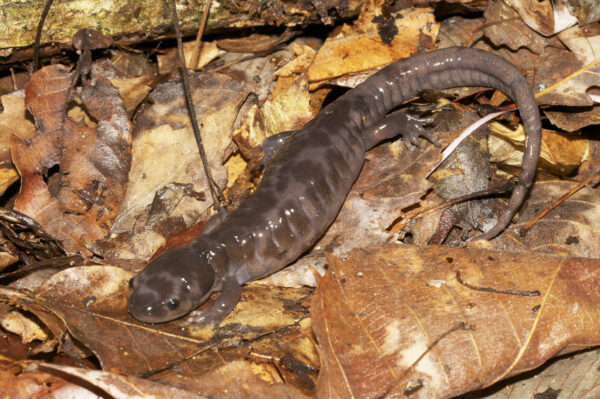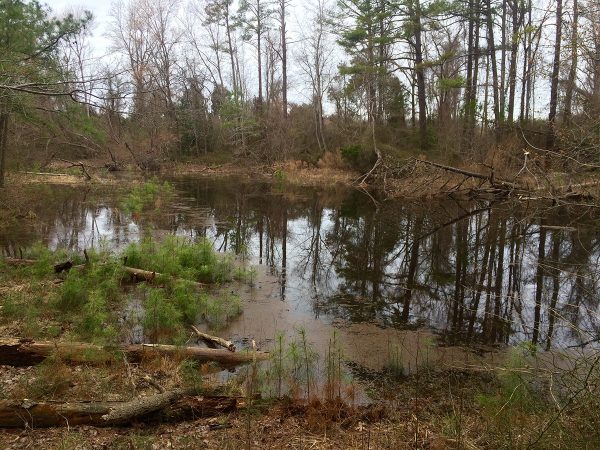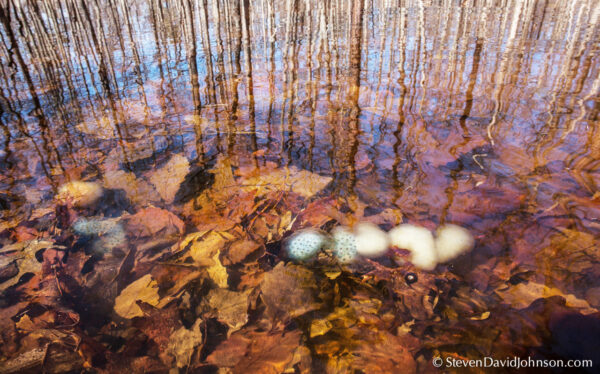
Spotted Salamander. © Will Lattea
It’s that time of year to watch for migrating salamanders! One of the species to be on the lookout for is the spotted salamander (Ambystoma maculatum), which can be found throughout most of Virginia. They belong to the group of salamanders often referred to as the mole salamanders because much of their adult life is spent underground and under logs or leaf litter foraging on invertebrates. But, when the time and weather are right, they come out in full force! The first “warm” rains of late winter and early spring beckon spotted salamanders to leave the underground and find a place to breed. (“Warm” is a relative term meaning just a few degrees above freezing.) These migrations to their breeding sites occur at night; since salamanders are amphibians, sunlight can threaten to dry out their moist, glandular skin.

Vernal Pools. Photo by John Bunch.
Vernal pools can be very small, often overlooked! Being rather dynamic and small makes them difficult for natural resource managers to pinpoint, manage, and map. To help with this, Virginia is lucky to have a large group of volunteers fascinated with this unique habitat, Virginia Master Naturalists (VMN)! Several chapters of VMN have been working with Virginia Department of Wildlife Resources (VDWR), Virginia Commonwealth University’s VCU Rice Rivers Center, and other state, local, and federal agencies, and other groups to get training and to find, identify, and monitor vernal pools on public lands. After training is provided by VCU, VMN, and VDWR (and maybe others in the future), small teams form at each chapter and coordinate with the respective resource manager(s) at a local public property to identify and monitor vernal pools. The data they collect is entered into an online database, using CitSci.org, where they must join and use a log in to do so. State agencies are able to download the data and use it for management and conservation of these important habitats.

Spotted salamander eggs in a vernal pool, photo by Steven David Johnson
Remember, as you are out looking for migrating salamanders or hiking through the woods at any time of year, always be careful where you step! Not only to avoid accidentally stepping on a salamander, but also to avoid stepping in the vernal pool. Entering vernal pools is discouraged, unless under advisement of a natural resource manager, because of the potential for deadly diseases to spread from one pool to the next. For the past few years, amphibian diseases such as Ranavirus and chytrid fungus or Bd have been known in Virginia, so disinfection protocols (compiled by PARC) are taught in the VMN trainings, for those who may enter pools at various sites. Now, there is another disease specific to salamanders, not yet known in Virginia, but it is known to occur overseas. It’s called Bsal, which is a salamander version of the chytrid fungus. To help prevent the spread of Bsal to the U.S., the U.S. Fish & Wildlife Service just made effective an interim rule banning many species of salamanders from being imported into the country and from any interstate transport.
For further information on salamanders and vernal pools, please check out sites of VDWR, the Virginia Herpetological Society (VHS), a Facebook page about the vernal pools in Virginia, as well as the many links provided throughout this article.


